Experimental Investigation of the Piezoresistive Properties of Cement Composites with Hybrid Carbon Fibers and Nanotubes
Abstract
:1. Introduction
2. Experimental Procedure
2.1. Preparation
2.2. Measurement
3. Self-Sensing Capacity of Cement-Based Composites with CFs
4. Self-Sensing Capacity of Cement-Based Composites with MWCNTs
5. Self-Sensing Capacity of Cement-Based Composites with Both CFs and MWCNTs
6. Conclusions
- (1)
- Although a cement paste with 1.0 vol.% CFs had 10 times more electrical resistivity and 21.0% greater porosity than a paste with 0.5 vol.% CFs, the amount of incorporated CFs must be greater than 0.5 vol.% in order to produce an adequate piezoresistive sensing capacity. The percolation threshold of CFs is thus between 0.5 and 1.0 vol.% of the cement paste.
- (2)
- Increasing the amount of MWCNTs in the paste increased the sensing sensitivity during cyclic compression tests. A 1.0 vol.% MWCNTs in the paste is sufficient for a strain sensor.
- (3)
- The amount of MWCNTs incorporated with CFs should be at least 0.35 vol.% in order to produce sufficient piezoresistive sensing capacity. Also, the amount of incorporated CFs should be minimized to enhance sensing capacity.
- (4)
- The cement-based sensor with 0.1 vol.% CFs and 0.5 vol.% MWCNTs had equivalent sensing performance to the composite with 1.0 vol.% MWCNTs at half the price. The GF is 160.3 with an R-square of 0.9274, which is similar to the GF of 166.6 for the composite with 1.0 vol.% MWCNTs.
Acknowledgments
Author Contributions
Conflicts of Interest
References
- Song, G.; Mo, Y.L.; Otero, K.; Gu, H. Health monitoring and rehabilitation of a concrete structure using intelligent materials. Smart Mater. Struct. 2006, 15, 309–314. [Google Scholar] [CrossRef]
- Li, H.N.; Li, D.S.; Song, G.B. Recent applications of fiber optic sensors to health monitoring in civil engineering. Eng. Struct. 2004, 26, 1647–1657. [Google Scholar] [CrossRef]
- Wang, C.S.; Wu, F.; Chang, F.-K. Structural health monitoring from fiber-reinforced composites to steel-reinforced concrete. Smart Mater. Struct. 2001, 10, 548–552. [Google Scholar] [CrossRef]
- Chang, P.C.; Flatau, A.; Liu, S.C. Review paper: Health monitoring of civil infrastructure. Struct. Health Monit. 2003, 2, 257–267. [Google Scholar] [CrossRef]
- Amey, S.L.; Johnson, D.A.; Miltenberger, M.A.; Farzam, H. Predicting the service life of concrete marine structures: An environmental methodology. ACI Struct. J. 1998, 95, 205–214. [Google Scholar]
- Enright, M.P.; Frangopol, D.M. Service-life prediction of deteriorating concrete bridges. J. Struct. Eng. ASCE 1998, 124, 309–317. [Google Scholar] [CrossRef]
- Lee, S.-J.; Zi, G.; Mun, S.; Kong, J.S.; Choi, J.-H. Probabilistic prognosis of fatigue crack growth for asphalt concretes. Eng. Fract. Mech. 2015, 141, 212–229. [Google Scholar] [CrossRef]
- Han, B.; Ou, J. Embedded piezoresistive cement-based stress/strain sensor. Sens. Actuators A Phys. 2007, 138, 294–298. [Google Scholar] [CrossRef]
- Loamrat, K.; Sappakittipakorn, M.; Sukontasukkul, P.; Banthia, N. Effect of carbon fiber and graphite powder on resistivity of cement-based sensor under compression. King Mongkut’s Univ. Technol. North Bangkok Int. J. Appl. Sci. Technol. 2014, 7, 29–35. [Google Scholar] [CrossRef]
- Azhari, F.; Banthia, N. Carbon fiber-reinforced cementitious composites for tensile strain sensing. ACI Mater. J. 2017, 114, 129–136. [Google Scholar]
- Chen, B.; Wu, K.; Yao, W. Conductivity of carbon fiber reinforced cement-based composites. Cem. Concr. Compos. 2004, 26, 291–297. [Google Scholar] [CrossRef]
- Han, B.; Han, B.Z.; Ou, J.P. Experimental study on use of nickel powder-filled Portland cement-based composite for fabrication of piezoresistive sensors with high sensitivity. Sens. Actuators A Phys. 2009, 149, 51–55. [Google Scholar] [CrossRef]
- Han, B.; Ding, S.; Yu, X. Intrinsic self-sensing concrete and structures: A review. Measurement 2015, 59, 110–128. [Google Scholar] [CrossRef]
- Chen, P.W.; Chung, D.D.L. Carbon fiber reinforced concrete as a smart material capable of non-destructive flaw detection. Smart. Mater. Struct. 1993, 2, 22–30. [Google Scholar] [CrossRef]
- Han, B.G.; Zhang, K.; Burnham, T.; Kwon, E.; Yu, X. Integration and road tests of a self-sensing CNT concrete pavement system for traffic detection. Smart. Mater. Struct. 2013, 22, 015020. [Google Scholar] [CrossRef]
- Konsta-Gdoutos, M.S.; Aza, C.A. Self sensing carbon nanotube (CNT) and nanofiber (CNF) cementitious composites for real time damage assessment in smart structures. Cem. Concr. Compos. 2014, 53, 162–169. [Google Scholar] [CrossRef]
- Ubertini, F.; Materazzi, A.L.; D’Alessandro, A.; Laflamme, S. Natural frequencies identification of a reinforced concrete beam using carbon nanotube cement-based sensors. Eng. Struct. 2014, 60, 265–275. [Google Scholar] [CrossRef]
- Lim, M.-J.; Lee, H.K.; Nam, I.-W.; Kim, H.-K. Carbon nanotube/cement composites for crack monitoring of concrete structures. Compos. Struct. 2017, 180, 741–750. [Google Scholar] [CrossRef]
- Sun, M.-Q.; Liew, R.J.Y.; Zhang, M.-H.; Li, W. Development of cement-based strain sensor for health monitoring of ultra high strength concrete. Constr. Build. Mater. 2014, 65, 630–637. [Google Scholar] [CrossRef]
- Kim, H.K.; Park, I.S.; Lee, H.K. Improved piezoresistive sensitivity and stability of CNT/cement mortar composites with low water–binder ratio. Compos. Struct. 2014, 116, 713–719. [Google Scholar] [CrossRef]
- Metha, P.K.; Monteiro, P.J.M. Concrete: Microstructure, Properties, and Materials, 3rd ed.; McGraw-Hill Publishing: New York, NY, USA, 2006. [Google Scholar]
- D’Alessandro, A.; Rallini, M.; Ubertini, F.; Materazzi, A.L.; Kenny, J.M. Investigations on scalable fabrication procedures for self-sensing carbon nanotube cement-matrix composites for SHM applications. Cem. Concr. Compos. 2016, 65, 200–213. [Google Scholar] [CrossRef]
- Gay, C.; Sanchez, F. Performance of carbon nanofiber-cement composites with a high-range water reducer. Transport. Res. Rec. J. Transport. Res. Board 2010, 2142, 109–113. [Google Scholar] [CrossRef]
- Han, B.G.; Yu, Y.; Han, B.Z.; Ou, J.P. Development of a wireless stress/strain measurement system integrated with pressure-sensitive nickel powder-filled cement-based sensors. Sens. Actuators A Phys. 2008, 147, 536–543. [Google Scholar] [CrossRef]
- Luo, J.; Duan, Z.; Zhao, T.; Li, Q. Hybrid effect of carbon fiber on piezoresistivity of carbon nanotube cement-based composite. Adv. Mater. Res. 2011, 143–144, 639–643. [Google Scholar] [CrossRef]
- Azhari, F.; Banthia, N. Cement-based sensors with carbon fibers and carbon nanotubes for piezoresistive sensing. Cem. Concr. Compos. 2012, 34, 866–873. [Google Scholar] [CrossRef]
- Ou, J.; Han, B. Piezoresistive cement-based strain sensors and self-sensing concrete components. J. Intell. Mater. Syst. Struct. 2009, 20, 329–336. [Google Scholar]
- Fan, X.; Fang, D.; Sun, M.; Li, Z. Piezoresistivity of carbon fiber graphite cement-based composites with CCCW. J. Wuhan Univ. Technol. Mater. Sci. Ed. 2011, 25, 339–343. [Google Scholar] [CrossRef]
- Luo, J.; Duan, Z.; Zhao, T.; Li, Q. Self-sensing property of cementitious nanocomposites hybrid with nanophase carbon nanotube and carbon black. Adv. Mater. Res. 2011, 143–144, 644–647. [Google Scholar] [CrossRef]
- Lin, V.W.J.; Li, M.; Lynch, J.P.; Li, V.C. Mechanical and electrical characterization of self-sensing carbon black ECC. Proc. SPIE 2011, 7983, 798316. [Google Scholar]
- Kim, H.K.; Nam, I.W.; Lee, H.K. Enhanced effect of carbon nanotube on mechanical and electrical properties of cement composites by incorporation of silica fume. Compos. Struct. 2014, 107, 60–69. [Google Scholar] [CrossRef]
- Yoo, D.-Y.; You, I.; Lee, S.-J. Electrical properties of cement-based composites with carbon nanotubes, graphene, and graphite nanofibers. Sensor 2017, 17, 1064. [Google Scholar] [CrossRef] [PubMed]
- Yoo, D.-Y.; You, I.; Lee, S.-J. Electrical and piezoresistive properties of cement composites with carbon nanomaterials. J. Compos. Mater. 2017. under review. [Google Scholar]
- Raki, L.; Beaudoin, J.; Alizadeh, R.; Makar, J.; Sato, T. Cement and concrete nanoscience and nanotechnology. Materials 2010, 3, 918–942. [Google Scholar] [CrossRef]
- Han, B.; Guan, X.; Ou, J. Electrode design, measuring method and data acquisition system of carbon fiber cement paste piezoresistive sensors. Sens. Actuators A Phys. 2007, 135, 360–369. [Google Scholar] [CrossRef]
- Zeng, Q.; Li, K.; Fen-Chong, T.; Dangla, P. Pore structure characterization of cement pastes blended with high-volume fly-ash. Cem. Concr. Res. 2012, 42, 194–204. [Google Scholar] [CrossRef]
- Li, G.Y.; Wang, P.M.; Zhao, X. Mechanical behavior and microstructure of cement composites incorporating surface-treated multi-walled carbon nanotubes. Carbon 2005, 43, 1239–1245. [Google Scholar] [CrossRef]
- Fu, X.; Lu, W.; Chung, D.D.L. Ozone treatment of carbon fiber for reinforcing cement. Carbon 1998, 36, 1337–1345. [Google Scholar] [CrossRef]
- Wen, S.; Chung, D.D.L. The role of electronic and ionic conduction in the electrical conductivity of carbon fiber reinforced cement. Carbon 2006, 44, 2130–2138. [Google Scholar] [CrossRef]
- Ibarra, L.; Macias, A.; Palma, E. Stress-Strain and stress relaxation in oxidated short carbon fiber-thermoplastic elastomer composites. J. Appl. Polym. Sci. 1996, 61, 2447–2454. [Google Scholar] [CrossRef]
- Tiwari, S.; Bijwe, J. Surface treatment of carbon fibers—A review. Proc. Tech. 2014, 14, 505–512. [Google Scholar] [CrossRef]
- Delamar, M.; Desarmot, G.; Fagebaume, O.; Hitmi, R.; Pinsonc, J.; Savéant, J.M. Modification of carbon fiber surfaces by electrochemical reduction of aryl diazonium salts: Application to carbon epoxy composites. Carbon 1997, 35, 801–807. [Google Scholar] [CrossRef]
- Fu, X.; Chung, D.D.L. Self-monitoring of fatigue damage in carbon fiber reinforced cement. Cem. Concr. Res. 1996, 26, 15–20. [Google Scholar] [CrossRef]
- Yoo, D.-Y.; You, I.; Lee, S.-J. Electrical and piezoresistive sensing capacities of cement paste with multi-walled carbon nanotubes. Arch. Civil Mech. Eng. 2017. accepted. [Google Scholar]
- Reza, F.; Batson, G.B.; Yamamuro, J.A.; Lee, J.S. Volume electrical resistivity of carbon fiber cement composites. ACI Mater. J. 2001, 98, 25–35. [Google Scholar]


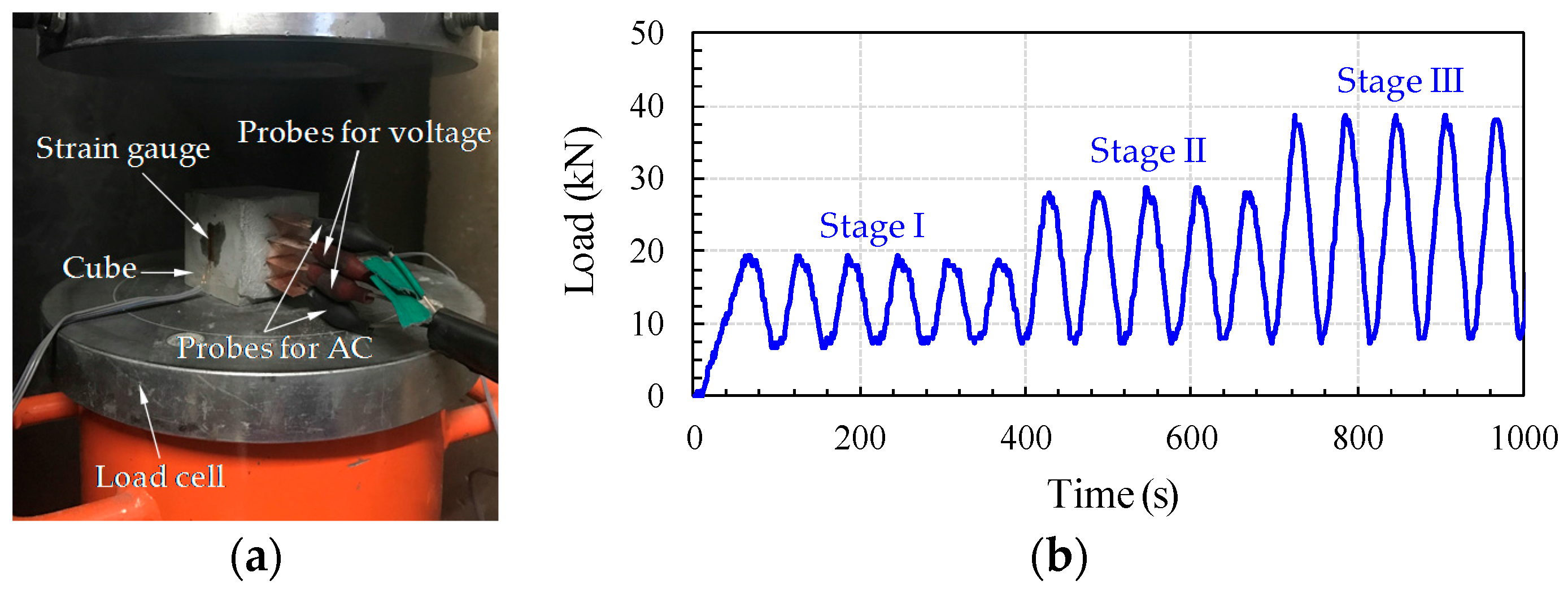

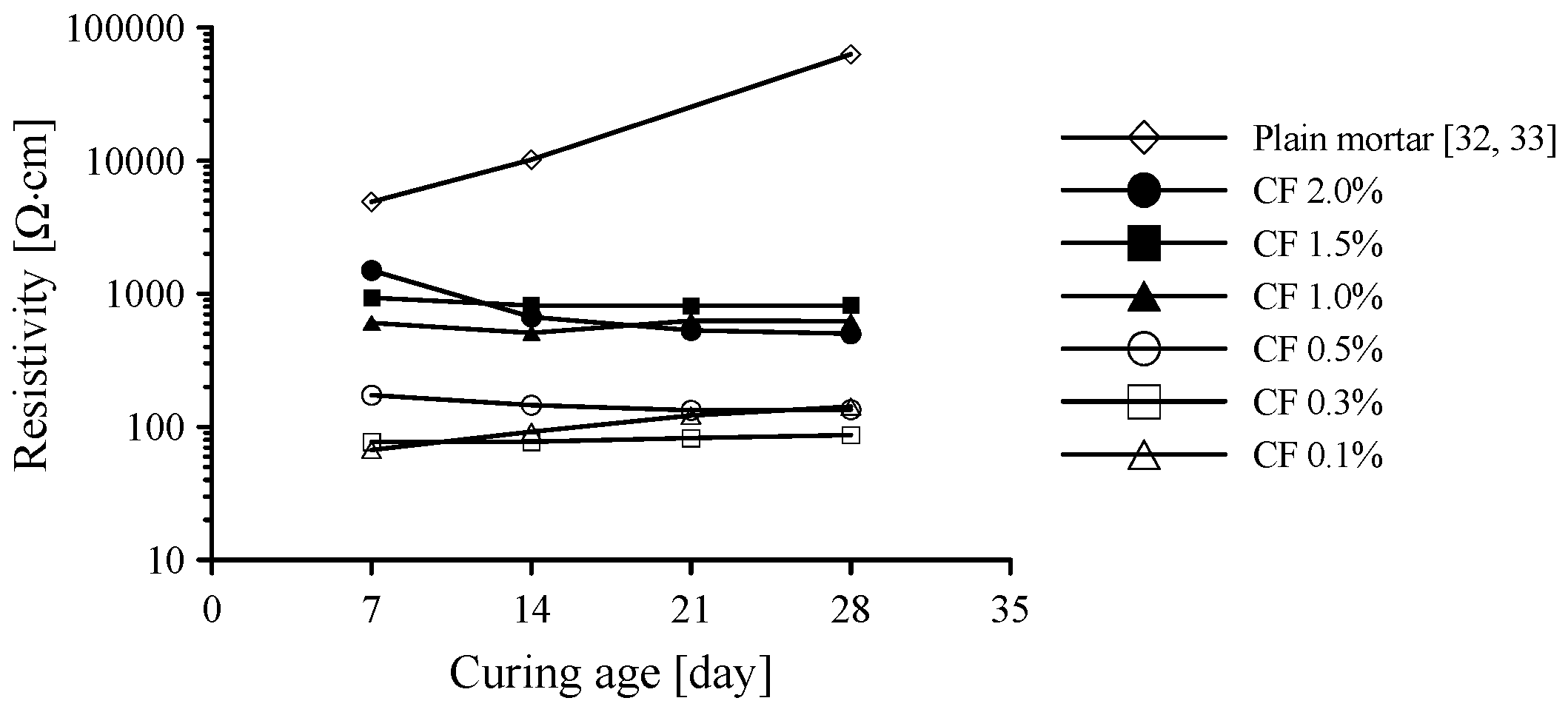
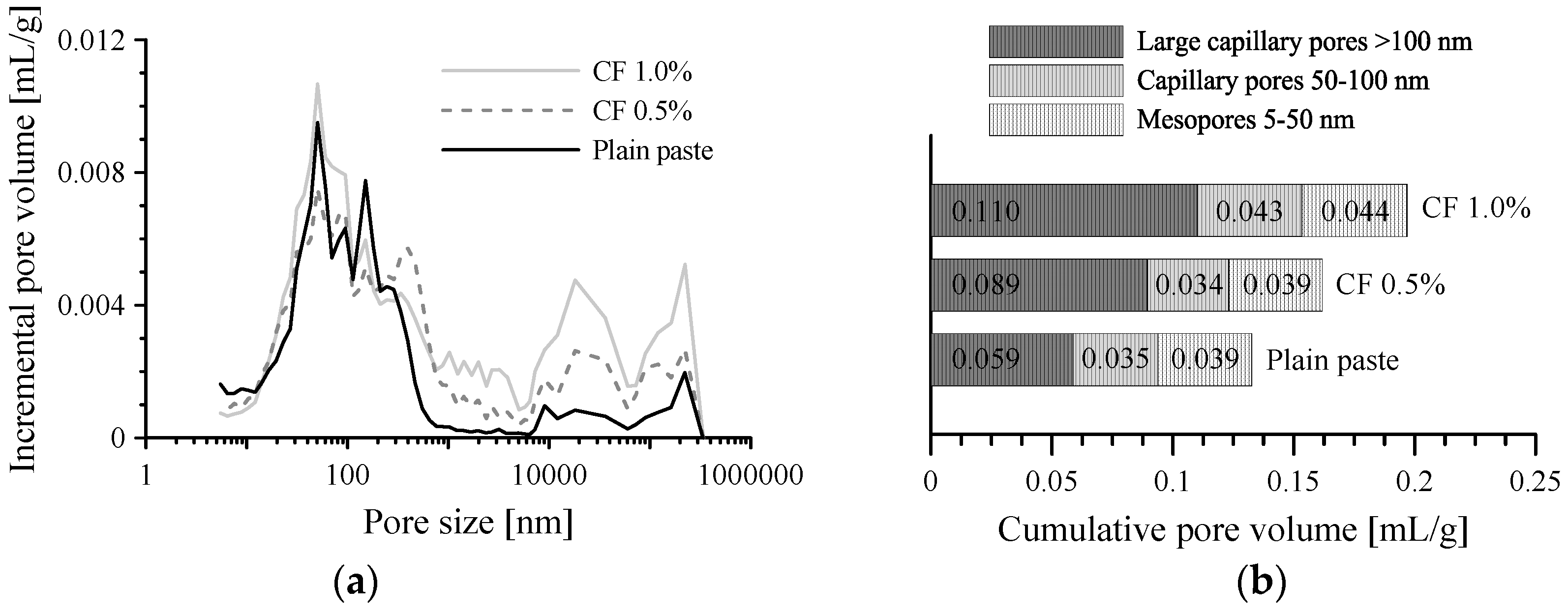
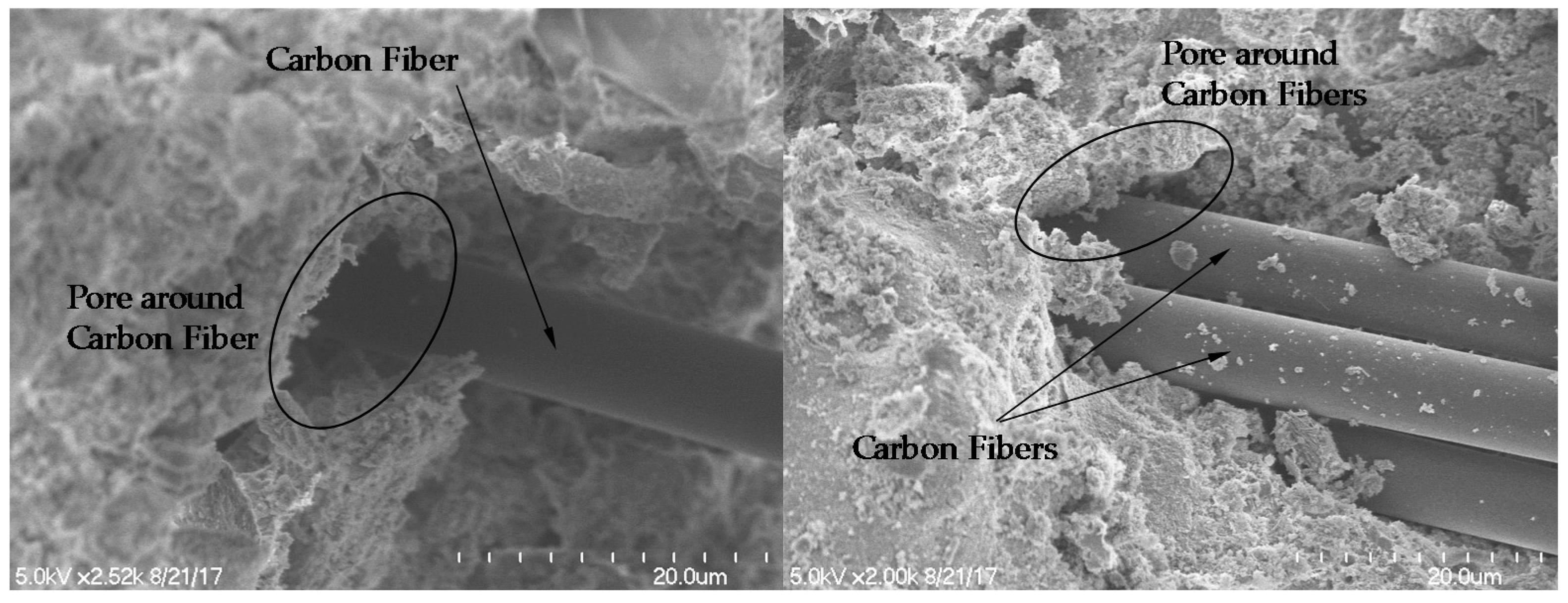
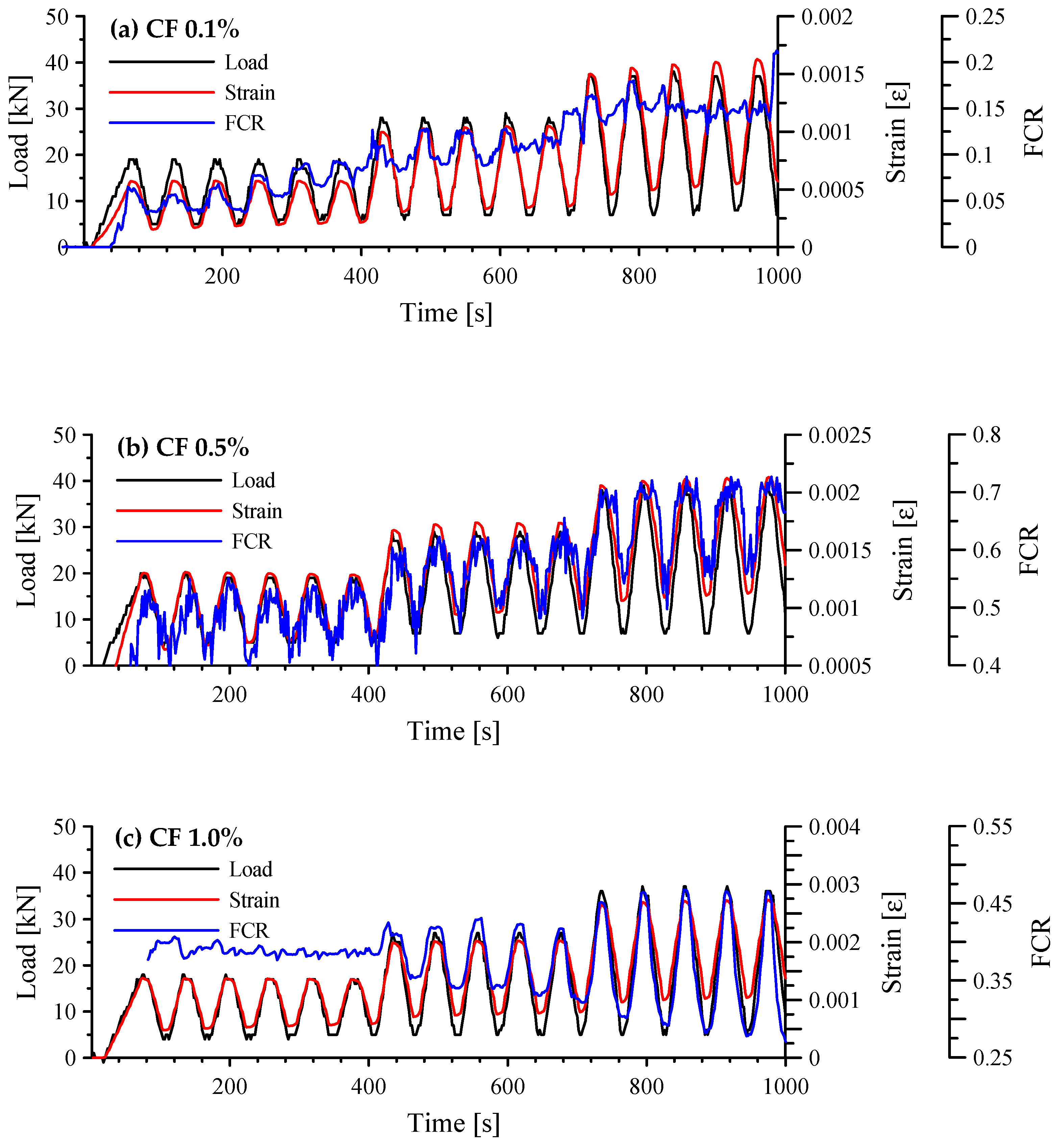
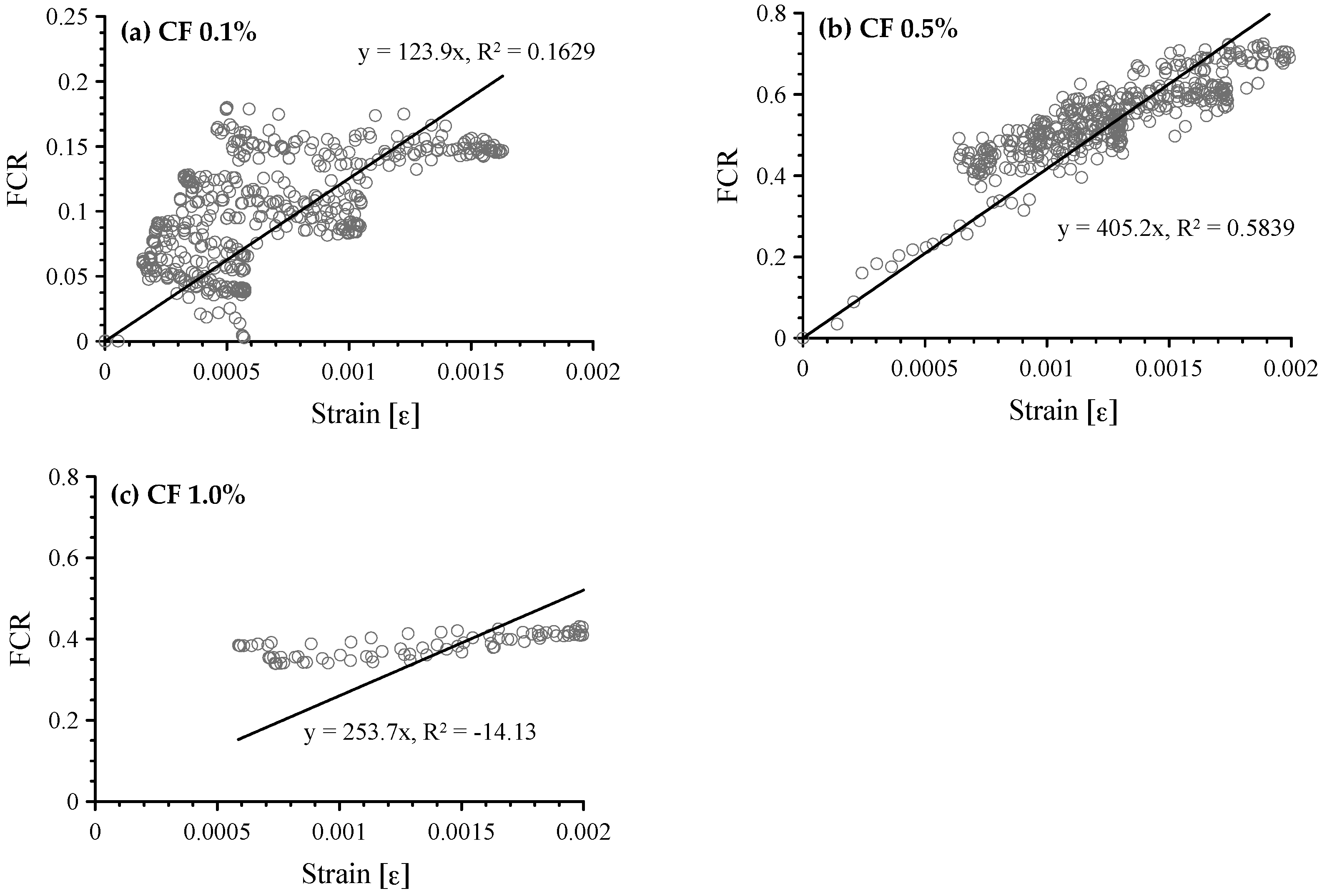
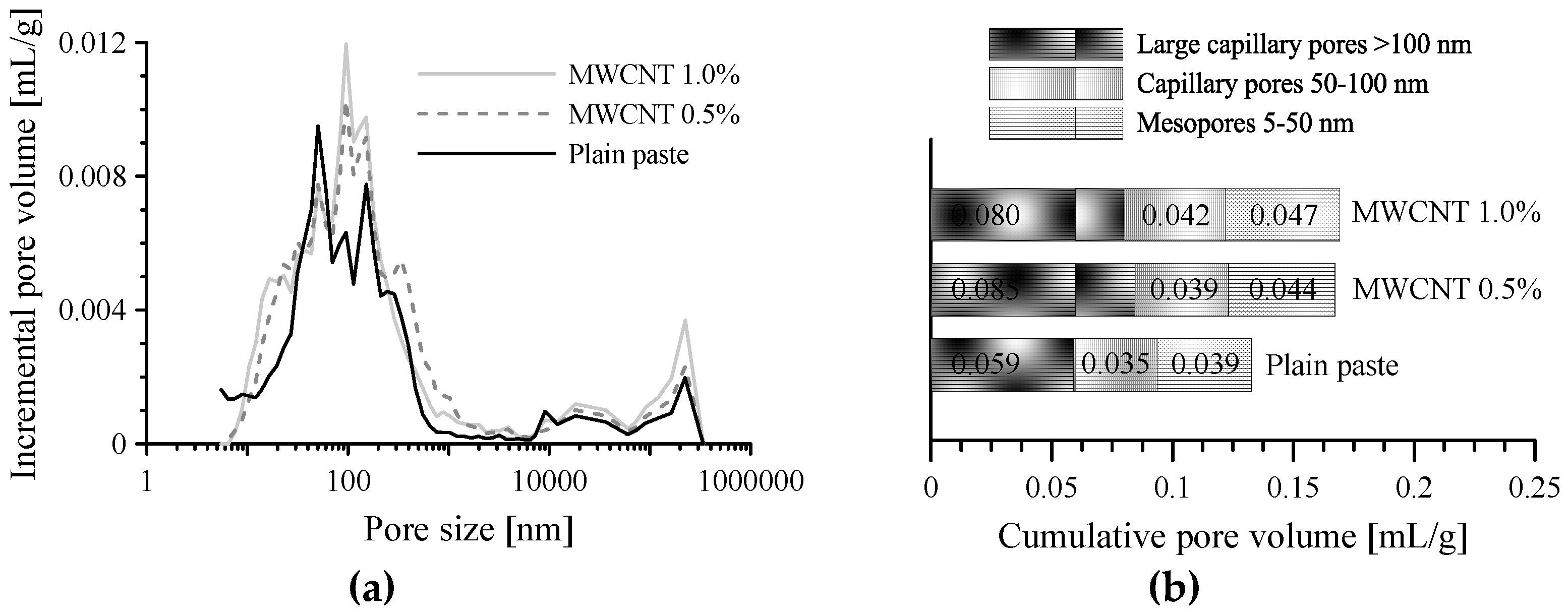


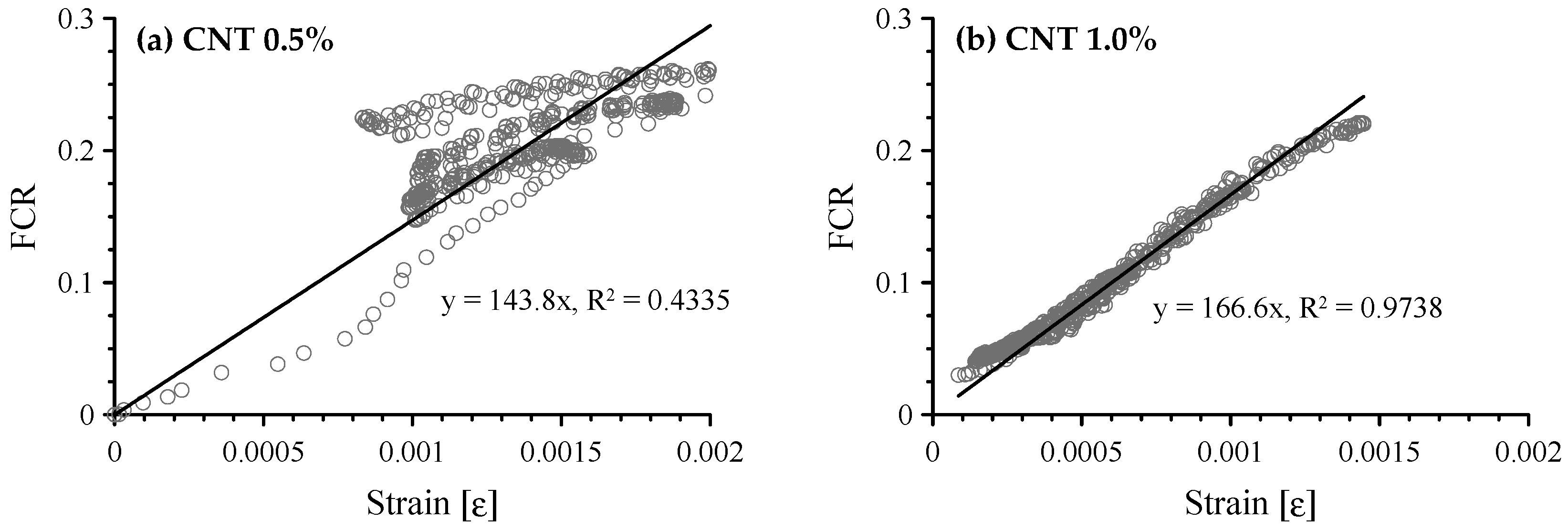

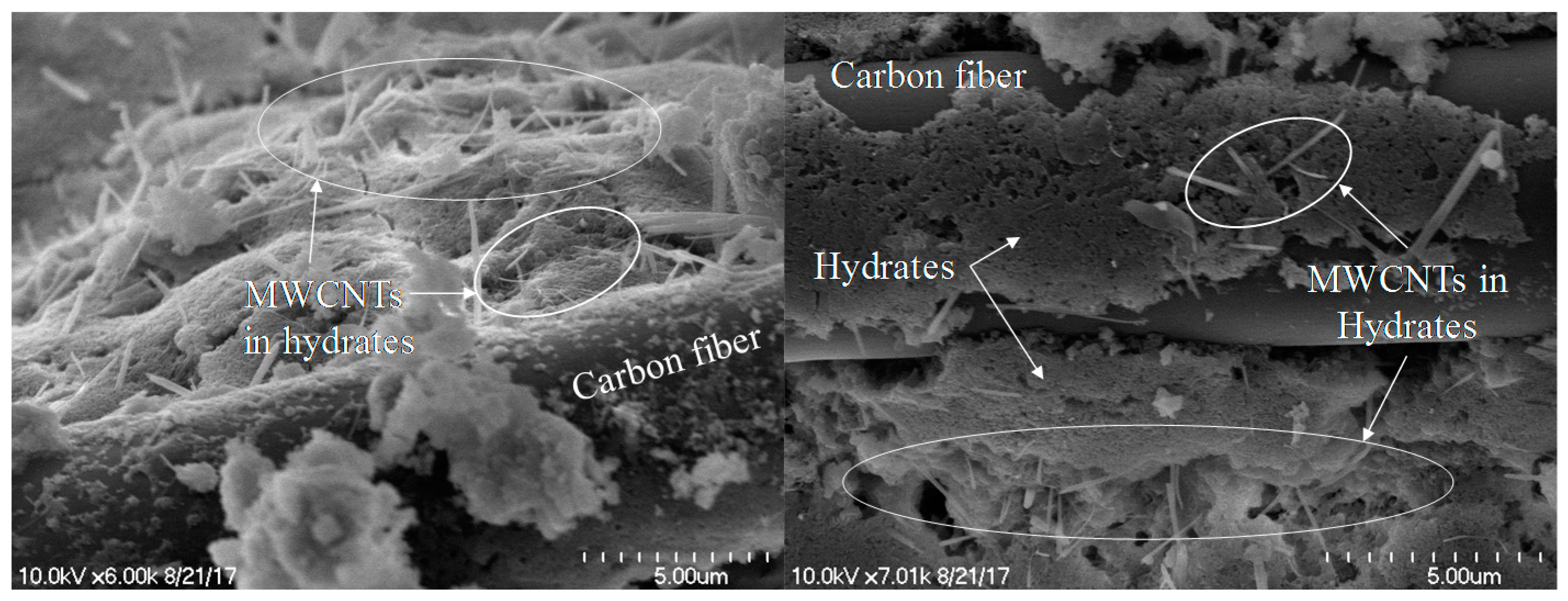

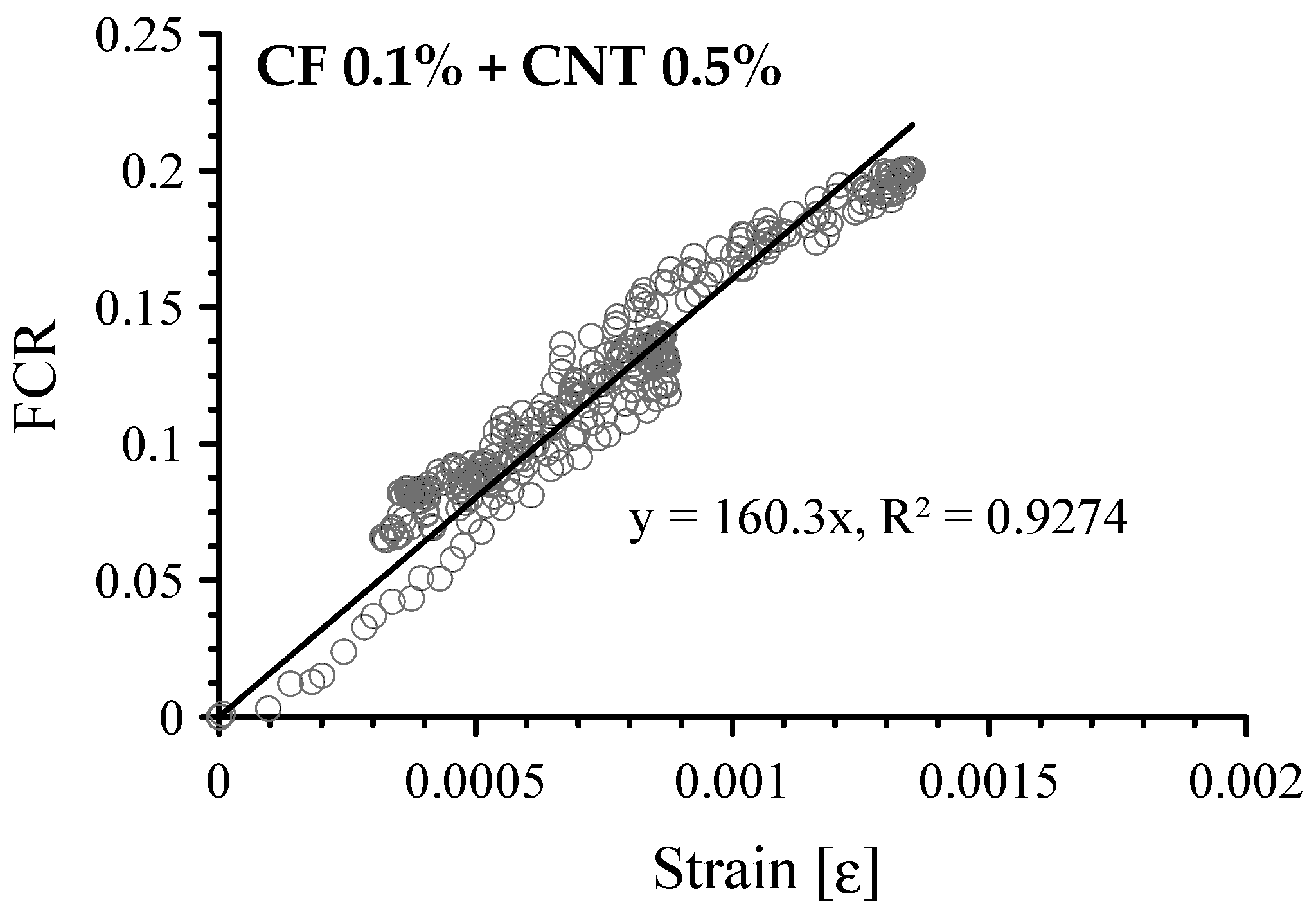
| Composition % (Mass) | Cement | Silica Fume |
|---|---|---|
| CaO | 61.33 | 0.38 |
| Al2O3 | 6.40 | 0.25 |
| SiO2 | 21.01 | 96.00 |
| Fe2O3 | 3.12 | 0.12 |
| MgO | 3.02 | 0.10 |
| SO3 | 2.30 | - |
| Specific surface area (cm2/g) | 3,413 | 200,000 |
| Density (g/cm3) | 3.15 | 2.10 |
| Ig. loss (%) | 1.40 | 1.50 |
| Diameter (nm) | Length (mm) | Carbon Content (%) | Aspect Ratio | Density (g/cm3) | Cost * ($/vol.% of m3) | |
|---|---|---|---|---|---|---|
| CF | 10,000 | 6 | 93 | >600 | 1.80 | 318 |
| MWCNT | 15 | 0.01 | >90 | >500 | 1.20 | 1695 |
| Group | W/B | SF/OPC | CFs * [%] | MWCNTs * [%] | CFs/MWCNTs | SP ** [%] | Cost *** ($/m3) | |
|---|---|---|---|---|---|---|---|---|
| Reference | Plain paste | 0.35 | 0.3 | - | - | - | - | - |
| CFs | CF0.1 | 0.1 | - | - | - | 31.8 | ||
| CF0.5 | 0.5 | - | - | 1.5 | 159 | |||
| CF1.0 | 1.0 | - | - | 1.9 | 318 | |||
| MWCNTs | MWCNT0.5 | - | 0.5 | - | 1.0 | 847.5 | ||
| MWCNT1.0 | - | 1.0 | - | 1.6 | 1695 | |||
| Hybrid | CF0.1CNT0.5 | 0.1 | 0.5 | 0.2 | 1.1 | 879.3 | ||
| CF0.15CNT0.35 | 0.15 | 0.35 | 0.43 | 1.3 | 640.95 | |||
| CF0.25CNT0.25 | 0.25 | 0.25 | 1.0 | 1.4 | 503.25 | |||
| CF0.35CNT0.15 | 0.35 | 0.15 | 2.33 | 1.4 | 365.55 | |||
| Group | GF | |
|---|---|---|
| Reference | Plain Paste | |
| CFs | CF0.1 | 123.9 (R2 = 0.1629) |
| CF0.5 | 405.2 (R2 = 0.5839) | |
| CF1.0 | 253.7 (R2 = −14.13) | |
| MWCNTs | MWCNT0.5 | 143.8 (R2 = 0.4335) |
| MWCNT1.0 | 166.6 (R2 = 0.9738) | |
| Hybrid | CF0.1CNT0.5 | 160.3 (R2 = 0.9274) * |
| CF0.15CNT0.35 | 74.2 (R2 = −0.682) | |
| CF0.25CNT0.25 | 79.5 (R2 = 0.4273) | |
| CF0.35CNT0.15 | 32.1 (R2 = 0.2464) | |
© 2017 by the authors. Licensee MDPI, Basel, Switzerland. This article is an open access article distributed under the terms and conditions of the Creative Commons Attribution (CC BY) license (http://creativecommons.org/licenses/by/4.0/).
Share and Cite
Lee, S.-J.; You, I.; Zi, G.; Yoo, D.-Y. Experimental Investigation of the Piezoresistive Properties of Cement Composites with Hybrid Carbon Fibers and Nanotubes. Sensors 2017, 17, 2516. https://doi.org/10.3390/s17112516
Lee S-J, You I, Zi G, Yoo D-Y. Experimental Investigation of the Piezoresistive Properties of Cement Composites with Hybrid Carbon Fibers and Nanotubes. Sensors. 2017; 17(11):2516. https://doi.org/10.3390/s17112516
Chicago/Turabian StyleLee, Seung-Jung, Ilhwan You, Goangseup Zi, and Doo-Yeol Yoo. 2017. "Experimental Investigation of the Piezoresistive Properties of Cement Composites with Hybrid Carbon Fibers and Nanotubes" Sensors 17, no. 11: 2516. https://doi.org/10.3390/s17112516




